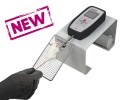Authors
L Ma?as-Garc?a, M Guitart, X Duran, E Barreiro
Lab
Pulmonology Department-Muscle Wasting and Cachexia in Chronic Respiratory Diseases and Lung Cancer Research Group, IMIM-Hospital del Mar, Parc de Salut Mar, Health and Experimental Sciences Department (CEXS), Universitat Pompeu Fabra (UPF), Barcelona Biomedical Research Park (PRBB), Barcelona, Spain
Journal
Nutrients
Abstract
We hypothesized that treatment with pharmacological agents known to increase sirtuin-1 activity (resveratrol and curcumin) may enhance muscle regeneration. In limb muscles of mice (C57BL/6J, 10 weeks) exposed to reloading for seven days following a seven-day period of hindlimb immobilization with/without curcumin or resveratrol treatment, progenitor muscle cell numbers (FACS), satellite cell subtypes (histology), early and late muscle regeneration markers, phenotype and morphometry, sirtuin-1 activity and content, and muscle function were assessed. Treatment with either resveratrol or curcumin in immobilized muscles elicited a significant improvement in numbers of progenitor, activated, quiescent, and total counts of muscle satellite cells, compared to non-treated animals. Treatment with either resveratrol or curcumin in reloaded muscles compared to non-treated mice induced a significant improvement in the CSA of both hybrid (curcumin) and fast-twitch fibers (resveratrol), sirtuin-1 activity (curcumin), sirtuin-1 content (resveratrol), and counts of progenitor muscle cells (resveratrol). Treatment with the pharmacological agents resveratrol and curcumin enhanced the numbers of satellite cells (muscle progenitor, quiescent, activated, and total satellite cells) in the unloaded limb muscles but not in the reloaded muscles. These findings have potential clinical implications as treatment with these phenolic compounds would predominantly be indicated during disuse muscle atrophy to enhance the muscle regeneration process.

 Pain - Thermal Allodynia / Hyperalgesia
Pain - Thermal Allodynia / Hyperalgesia Pain - Spontaneous Pain - Postural Deficit
Pain - Spontaneous Pain - Postural Deficit Pain - Mechanical Allodynia / Hyperalgesia
Pain - Mechanical Allodynia / Hyperalgesia Learning/Memory - Attention - Addiction
Learning/Memory - Attention - Addiction Physiology & Respiratory Research
Physiology & Respiratory Research
 Pain
Pain Central Nervous System (CNS)
Central Nervous System (CNS) Neurodegeneration
Neurodegeneration Sensory system
Sensory system Motor control
Motor control Mood Disorders
Mood Disorders Other disorders
Other disorders Muscular system
Muscular system Joints
Joints Metabolism
Metabolism Cross-disciplinary subjects
Cross-disciplinary subjects Preclinical studies and opioids: role in crisis management in the United States
Preclinical studies and opioids: role in crisis management in the United States 